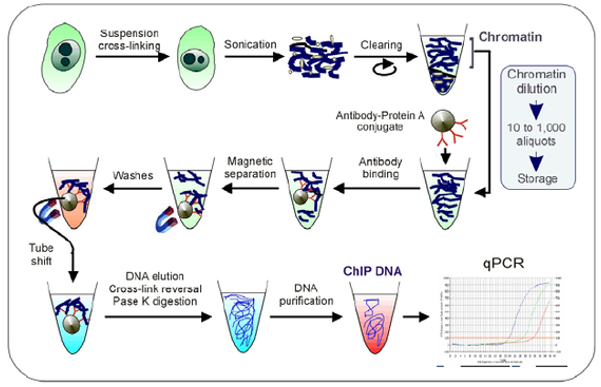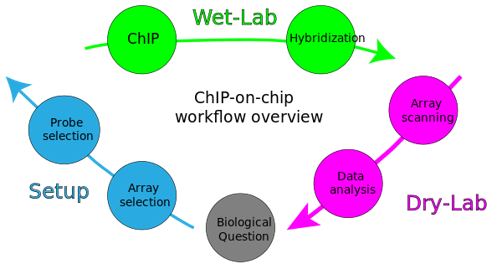Chromatin immunoprecipitation (ChIP) is an IP technique that help understand the interactions between biological proteins and DNA. The study illustrates the cross-linking of DNA and related proteins on chromatin in living cells or tissues. ChIP analysis identifies DNA-protein interactions in the genome through histone modifications, transcription factors, and chromatin switches to study transcriptional regulation of chromatin occupancy. Creative Biolabs provides scientists with cutting-edge chip antibody products to obtain reliable data. Efficiency and quality are our service tenets, allowing you to experience our professionalism and service quality.
 Fig 1. Quick and quantitative (Q 2 )ChIP. (Collas P, 2008)
Fig 1. Quick and quantitative (Q 2 )ChIP. (Collas P, 2008)
Why choose ChIP antibody?
- When the target of interest has been tested in IP, it is likely that the antibody will work in ChIP. ChIP-WB is another novel method, which will pull down the interested protein and can provide information about uniqueness. Other methods identify targets in their native state are also good indexes, such as ICC, IF, and IHC.
- More importantly, unless monoclonal antibodies are specifically screened or designed for ChIP, polyclonal antibodies are better candidates for recognizing the target because they identify multiple epitopes.
- ChIP has received widespread attention. Using magnetic beads to separate DNA-protein antibody complexes, which can improve the efficiency of ChIP, simplify the operation process, shorten the time, and also gain a fresh understanding of multiple target proteins. ChIP technology is often used as an ideal choice for researchers.
Antibody suitable for ChIP with functional applications
- ChIP-PCR can analyze histone-modifications, and the proteins can bind to a subset of known target sites in the genome. Using ChIP-qPCR allows rapid and quantitative comparison of specific genomic regions in different samples. This is cheaper and less time-consuming than WGS method. In ChIP-PCR, immuno-enriched DNA fragments can be detected and quantified using available PCR or qPCR method.
 Fig 2. Workflow overview of a ChIP-on-chip experiment.
Fig 2. Workflow overview of a ChIP-on-chip experiment.
- ChIP-chip technology relies on a DNA microarray chip to analyze ChIP immuno-enriched DNA fragments. ChIP-chip is useful in basic and disease research. For example, it can detect the binding sites of transcription factors and enhancers, which can contrast these binding proteins in control and pathological samples. However, the high cost of NGS has dropped dramatically. What’s more, the similar results can be obtained with ChIP-seq, so it is good to choose ChIP-seq rather than ChIP.
- ChIP-seq provides wide genome-information on protein-binding, which is the same as ChIP-chip technology. But the difference between ChIP-chip and ChIP-seq is that the latter uses NGS technology to detect DNA fragments and map them against the entire genome.
Reference
- Collas P, Dahl J A. Chop it, ChIP it, check it: the current status of chromatin immunoprecipitation[J]. Front Biosci, 2008, 13(17): 929-943.
| Cat | Product Name | Application | Species Reactivity |
|---|---|---|---|
| MO-MMB-0580 | Anti-FOXC1 Antibody (Cat MO-MMB-0580), Goat IgG | WB, IHC, ChIP | Human, Mouse, Zebrafish |
| MO-MMB-0687 | Anti-H2A Antibody (Cat MO-MMB-0687), Rabbit IgG | ChIP, IP, WB | Budding Yeast, Fission Yeast |
| MO-MMB-0688 | Anti-H2A Antibody (Cat MO-MMB-0688), Rabbit IgG | ChIP-qPCR, WB | Budding Yeast, Fission Yeast |
| MO-MMB-0689 | Anti-H2AS129ph Antibody (Cat MO-MMB-0689), Rabbit IgG | ChIP, WB | Budding Yeast |
| MO-MMB-0694 | Anti-H2B Antibody (Cat MO-MMB-0694), Rabbit IgG | ChIP, CUT&RUN, WB | Budding Yeast, Fission Yeast |
| MO-MMB-0690 | Anti-H2Av Antibody (Clone MMB1) (Cat MO-MMB-0690), Mouse IgG2a | ChIP, WB | Fruit fly |
| MO-MMB-0691 | Anti-Htz1 Antibody (Cat MO-MMB-0691), Rabbit IgG | ChIP-qPCR, ChIP-Seq, WB | Budding Yeast |
| MO-MMB-0692 | Anti-Pht1 Antibody (Cat MO-MMB-0692), Rabbit IgG | ChIP-qPCR, WB | Fission Yeast |
| MO-MMB-0704 | Anti-H3K56ac Antibody (Clone MMB4) (Cat MO-MMB-0704), Mouse IgG1 | ChIP, DB | Budding Yeast, Fission Yeast, Human |
| MO-MMB-0700 | Anti-H3K27ac Antibody (Cat MO-MMB-0700), Rabbit IgG | ChIP, ChIP-Seq, CUT&RUN, WB, DB | Budding Yeast, Human |
| MO-MMB-0699 | Anti-H3K27ac Antibody (Cat MO-MMB-0699), Rabbit IgG | ChIP, ChIP-Seq, Native ChIP, CUT&RUN, WB, IF, IHC(P), PLA | Budding Yeast, Human |
| MO-MMB-0705 | Anti-H3K56ac Antibody (Cat MO-MMB-0705), Rabbit IgG | ChIP, ChIP-Seq, WB, DB | Budding Yeast, Human |
| MO-MMB-0701 | Anti-H3K36me2 Antibody (Cat MO-MMB-0701), Rabbit IgG | CUT&RUN, ChIP, IF, WB, DB | Budding Yeast, Human |
| MO-MMB-0696 | Anti-H3K4me3 Antibody (Cat MO-MMB-0696), Rabbit IgG | ChIP-qPCR, ChIP-chip, ChIP-Seq, Native ChIP, CUT&RUN, CUT&Tag, WB, IF, FC, IHC(P), ELISA, PLA | Budding Yeast, Human, Mouse |
| MO-MMB-0697 | Anti-H3K4me3 Antibody (Cat MO-MMB-0697), Rabbit IgG | ChIP-qPCR, ChIP-Seq, Native ChIP, IF, WB | Budding Yeast, Human |
| MO-MMB-0698 | Anti-H3K9me3 Antibody (Cat MO-MMB-0698), Rabbit IgG | ChIP, ChIP-Seq, Native ChIP, IF, WB | Fission Yeast, Human |
| MO-MMB-0714 | Anti-RNA pol II Antibody (Clone MMB5) (Cat MO-MMB-0714), Mouse IgG1 | ChIP, IF, WB | Budding Yeast, C. elegans, Human, Mouse, Rat |
| MO-MMB-0686 | Anti-His1 Antibody (Clone MMB2) (Cat MO-MMB-0686), Mouse IgG1 | ChIP, ChIP-Seq, IP, IF, WB | Fruit fly |
| MO-MMB-0706 | Anti-H4K12ac Antibody (Cat MO-MMB-0706), Rabbit IgG | ChIP, ChIP-Seq, WB, IF | Budding Yeast, Human, Mouse |
| MO-MMB-0707 | Anti-H4K12ac Antibody (Cat MO-MMB-0707), Rabbit IgG | ChIP-Seq, IF | Budding Yeast, Human, Mouse |
| MO-MMB-0708 | Anti-H4K16ac Antibody (Cat MO-MMB-0708), Rabbit IgG | ChIP-qPCR, Chip-Seq, Native ChIP, WB, IF | Budding Yeast, Fruit fly, Human, Mouse |
| MO-MMB-0709 | Anti-H4K16ac Antibody (Cat MO-MMB-0709), Rabbit IgG | ChIP-qPCR, IHC, WB | Budding Yeast, Fruit fly, Human |
| MO-MMB-0711 | Anti-LexA Antibody (Cat MO-MMB-0711), Rabbit IgG | ChIP, WB | Budding Yeast |

